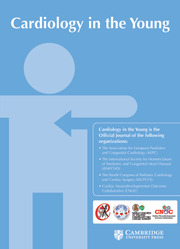No CrossRef data available.
Article contents
Early outcomes of left bundle branch area pacing in children
Published online by Cambridge University Press: 13 March 2025
Abstract
Left bundle branch area pacing is a recent technique gaining rapid acceptance due to its broader target area and excellent electrical parameters. The aim of this study was to demonstrate the feasibility of left bundle branch area pacing in children and share short-term results.
A retrospective study conducted at a single centre between December 2021 and April 2024 involved 19 children who underwent left bundle branch area pacing using Select Secure leads. The study included echocardiographic evaluations, pacing parameters, and follow-up outcomes.
The cohort comprised 10 males and 9 females. Median age was seven years (range 2–18), and median weight was 38 kg (range 13–56). All patients had complete atrioventricular block, with seven having isolated congenital complete atrioventricular block and 12 postoperative complete atrioventricular block. In nine patients, transitioning from epicardial to endocardial pacing resulted in ventricular dysfunction due to chronic right ventricular pacing. The remaining patients received left bundle branch area pacing initially. One patient underwent implantation in a septal position close to the left bundle due to left bundle branch area pacing infeasibility. The median post-procedure QRS duration was 92 msec (range 80–117). Median R wave amplitude, threshold, and impedance values were 14.7 mV (range 13.3–16.8), 0.7 mV (range 0.5–1.1), and 728 ohms (range 640–762), respectively. Atrioventricular (DDD mode) leads were implanted in 10 patients, and ventricular leads (VVIR mode) were implanted in nine patients. Median fluoroscopy dose was 18.7 mGy (13.5–34.52).
Left bundle branch area pacing can be safely conducted in paediatric patients exhibiting a narrow QRS duration and stable pacing parameters.
- Type
- Original Article
- Information
- Copyright
- © The Author(s), 2025. Published by Cambridge University Press



